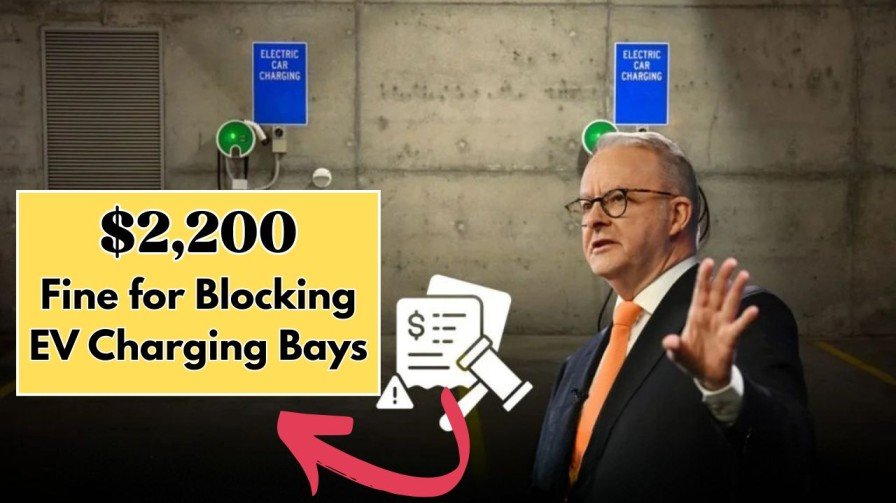Starting October 2025, Australia has introduced one of its toughest traffic penalties yet: a $2,200 fine for blocking electric vehicle (EV) charging bays. Whether you drive a petrol car, a diesel vehicle, or even an EV that isn’t plugged in, occupying a charging spot could now cost you thousands.
This rule comes as Australia pushes to expand its EV adoption and keep charging stations free for drivers who truly need them. Here’s everything you need to know about the new law, why it matters, and how to avoid this expensive mistake.
Why the New EV Charging Bay Rule Exists
Electric vehicle sales are rising fast—up 25% in 2024, with more than 100,000 EVs sold across the country. But charging infrastructure is still limited, with only 3,500 public chargers nationwide.
When petrol or diesel cars block charging bays—or even when EV drivers park without plugging in—it leaves others stranded. The $2,200 fine is designed to:
- Keep chargers available for EVs that need them.
- Support Australia’s net-zero emissions goal by 2050.
- Encourage responsible parking and fair access.
What Triggers the $2,200 Fine?
The law is simple: only EVs actively charging are allowed in EV bays.
| Situation | Fine? | Reason |
|---|---|---|
| Petrol/diesel car in EV bay | ✅ Yes | Non-EVs block chargers |
| EV parked but not charging | ✅ Yes | Wastes the bay |
| EV plugged in and charging | ❌ No | Correct use |
| Hybrid car not plugged in | ✅ Yes | Only charging EVs qualify |
| Stopping “just for a minute” | ✅ Yes | No exceptions allowed |
Even brief misuse—such as waiting inside the car—can trigger the fine, with cameras and wardens actively monitoring.
Where Are EV Charging Bays Located?
Charging bays are increasingly common in:
- Shopping centres and malls
- Petrol stations and highway stops
- Public and council car parks
- Dedicated EV hubs in urban areas
Look for green-painted spaces, EV-only signs, or charging station icons. Missing these could mean a costly mistake.
Why Is the Fine So High?
At $2,200, the penalty is far higher than a regular parking ticket ($100–$300) and even higher than some speeding fines. Authorities argue the steep cost is necessary to:
- Deter careless or entitled drivers.
- Protect EV owners who rely on limited charging points.
- Push petrol and diesel drivers to respect EV infrastructure.
Supporters say it’s a small price compared to the frustration of stranded EV drivers, while critics call it excessive.
How to Avoid the Fine
Avoiding a $2,200 mistake is simple if you follow the rules:
- ✅ Check signs and markings – Green bays = EV only.
- ✅ Never stop in an EV bay unless you’re actively charging.
- ✅ Use apps like PlugShare to locate chargers if you own an EV.
- ✅ Spread awareness – Tell friends and family about the new rule.
- ✅ When in doubt, park elsewhere.
What This Means for Australia’s Future
This law reflects Australia’s shift towards greener transport. With EVs expected to reach 50% of new car sales by 2030, charging demand will only grow. The government also plans to expand the charger network from 3,500 to 10,000 by 2027.
The $2,200 fine is not just about punishment—it’s about ensuring fairness and preparing for a future where EVs dominate Australian roads.
FAQs About Australia’s EV Charging Bay Fine
1. What’s the fine for blocking an EV charging bay in 2025?
The fine is $2,200, starting January 2025.
2. Can EVs park in charging bays without charging?
No. EVs must be plugged in and charging to use the bay.
3. Where can I find EV charging bays?
They’re located at shopping centres, malls, petrol stations, and public car parks—look for green paint or EV-only signs.
4. Why is the fine higher than other parking penalties?
It’s designed as a deterrent to stop misuse and protect limited charging infrastructure.
5. Can I stop briefly in an EV charging bay?
No. Even short stops can result in fines, as enforcement is strict.
Final Thoughts
Australia’s $2,200 EV charging bay fine is one of the toughest parking penalties in the country—and for good reason. With EV ownership growing and chargers still limited, keeping bays free is vital.
The rule is simple: only park in EV charging spots if you’re actively charging your vehicle. Respect the signs, stay alert, and save yourself from a fine that could ruin your day.

